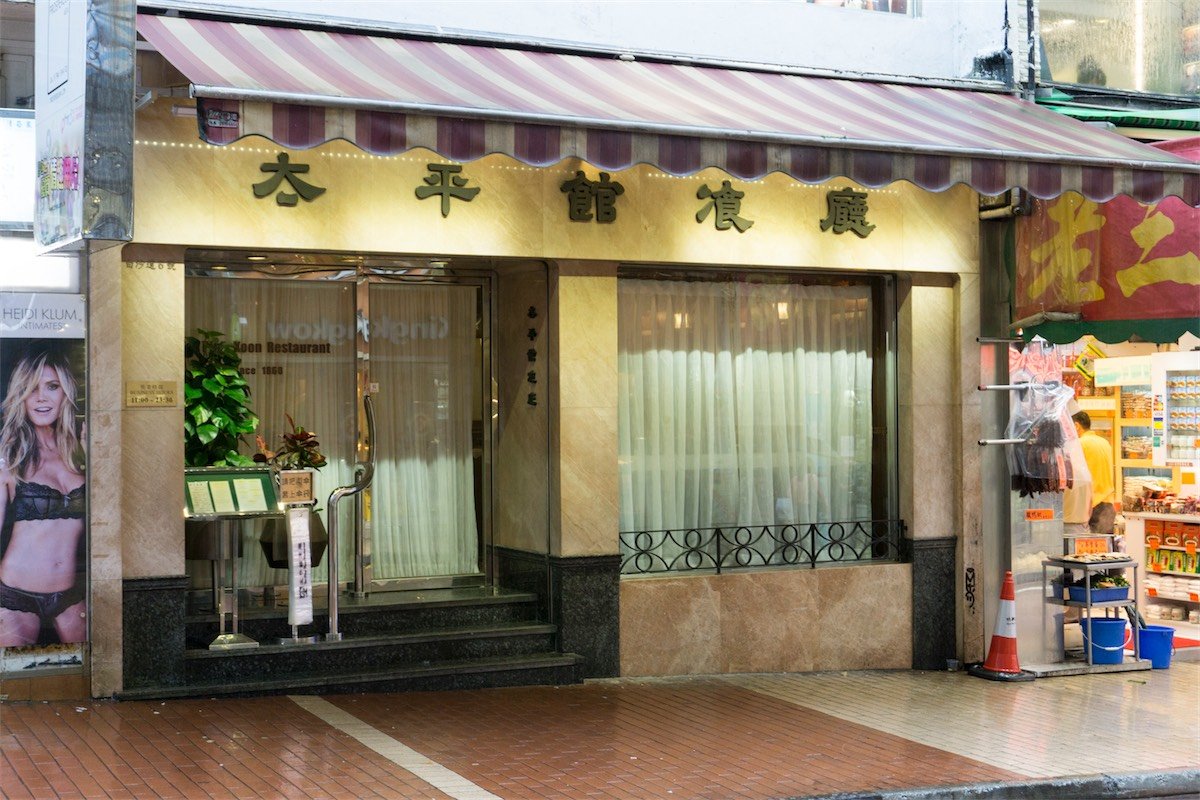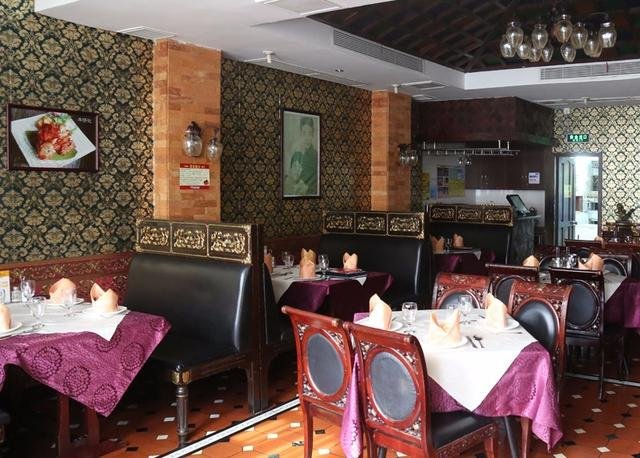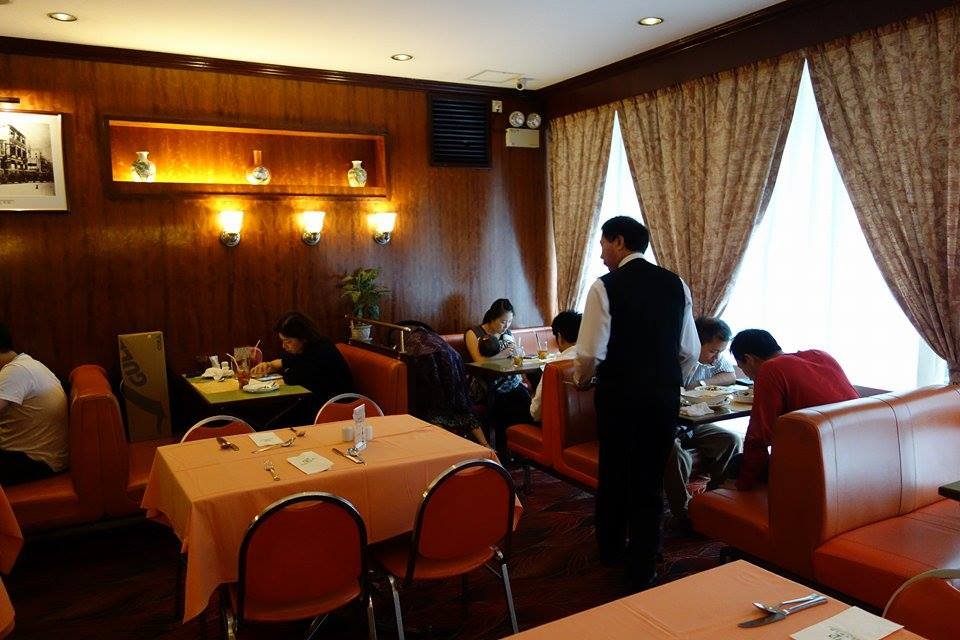走進香港街頭,你會發現香港是一個很特別的城市,因為它的近代史與中國及英文都有著千絲萬縷的關係。今天香港已回歸祖國懷抱,但你還會發現很多中英混雜的遺痕歷史,就像太平館餐廳。
Going into the HK’s streets, you will find Hong Kong is really a special city. It is because the modern history of Hong Kong is linked with China and Britain in countless ways. Today, Hong Kong has returned to the Motherland, but you still find a lot of history of Chinese and British in HK, like Tai Ping Koon Restaurant.

太平館餐廳。Camera: Sony A6000
Tai Ping Koon Restaurant. Camera: Song A6000
第一家中國人開設的西餐廳
The First Western Restaurant opened by Chinese
太平館餐廳成立於1860年,首店設於廣州太平沙。它是中國第一家由中國人經營的西餐廳。太平館的創辦人徐老高,原任洋行西廚,後來自立門戶,先在街頭擺路邊攤,更首創以中式醬油混合西式食品的菜式。後來於1860在廣州成立太平館 。
Kai Ping Kook Restaurant was opened in 1860. The first branch was located in Guangzhou. It is the first western restaurant opened by Chinese in China. The founder, Tsui Lo Ko, was a western cook and later opened the restaurant. He was the first person to use Chinese Sauce in the western meal.

中國第一間華人經營的西餐廳 (1860)。照片來源:太平館餐廳官方網站
The first western restaurant opened by Chinese in China (1860). Photo Source: Tai Ping Koon Restaurant Official Website
當年的太平館聞名廣東,有不少名人都曾到太平館設宴,如孫中山、蔣介石、宋美齡、汪精衛等,周恩來更是在太平館設晏迎娶鄧穎超。日本侵華期間,太平館第三代傳人徐漢初南下香港,成立了第一家香港太平館,後來廣州淪陷,廣州太平館關閉,香港太平館亦於香港淪陷後關閉。
Tai Ping Koon Restaurant was very famous among Guangdong. Many important politician at the period were also the clients of the restaurant. They include: Sun Yat-sen, Chiang Kai-shek, Soong May-ling, Wang Jingwei, etc. Even the wedding dinner of Zhou Enlai and Deng Yingchao was in Kai Ping Koon Restaurant also. During the Second Sino-Japanese War, the third generation of Tsui Lo Ko moved to Hong Kong and opened the first HK Tai Ping Kook Restaurant. Later, Guangzhou and Hong Kong were occupied by Japan, all Tai Ping Koon Restaurant.

今天的廣州太平館還掛有周恩來和鄧穎超當年的合照。照片來源:今日頭條
There is still the photo of Zhou Enlai and Deng Yingchao in Guangzhou Tai Ping Koon Restaurant. Photo Source: kknews

香港首家太平館餐廳(1939年). 照片來源:太平館餐廳官網
The first Tai Ping Koon Restaurant in Hong Kong (1939). Photo source: Tai Ping Koon Restaurant Official Website
廣州及香港重光後,兩地的太平館重新結業,1955年廣州太平館收歸國有,徐家離開廣州,全力經營香港太平館。
After World War II, Kai Ping Koon Restaurant reopened. In 1955, Guangzhou Tai Ping Koon was nationalized. The whole Tsui’s family moved to Hong Kong to operate HK Tai Ping Koon Restaurant.

香港太平館內還留有當年復業的剪報。照片來源:貓大爺粉絲團網誌
You can see the newspaper of Tai Ping Koon Restaurant reopening. Photo source: 貓大爺粉絲團網誌
瑞士雞翼的傳說
The Story of Swiss Wing
太平館至今在香港已有4家分店,裝修格局仍然保持民國其間西餐廳的格調,現存最古老的是佐敦分店,至今53年歷史。太平館最馳名的菜式就是瑞士雞翼,請留意瑞士雞翼不是瑞士菜而是香港菜式。瑞士雞翼其實是豉油雞翼,相傳當年有一位外國人到太平館,嚐過豉油雞翼後對侍應說 “Sweet! Sweet!” 由於侍應不懂英文,就向人請教這句的意思,慢慢就將”Sweet”誤傳成”Swiss”,讓老闆以為雞翼的味道近似瑞士風味,瑞士雞翼之名就不徑而走。
Nowadays, there are four branches in Tai Ping Koon Restaurant in Hong Kong. The decoration still remains the HK style of the 1930s-1940s. The oldest branch is the Jordon branch, with 53 years’ history. The most famous dish of Tai Ping Koon Restaurant is “Swiss Wing”. “Swiss Wing” is actually Hong Kong style chicken wing with soy sauce. There is a story: long time ago, a foreigner came to Tai Ping Koon Restaurant and try the soy sauce chicken wing. He told the waiter “Sweet! Sweet!”. The waiter didn’t know English and asked his boss. But he pronounced “Sweet” as “Swiss” and so the boss just thought the client said it was Swiss style and so called it “Swiss Wing”.

餐廳還保留著當年的味道。照片來源:香港獨立媒體
The decoration still remains the old HK style. Photo source: immediahk
今天,廣州的太平館已復業,香港的太平館亦已經是米芝蓮的一星餐廳。餐廳主打港式西餐,除了瑞士雞翼,更有多種著名菜式。
Today, the Guangzhou Tai Ping Koon Restaurant has reopened. And Hong Kong Tai Ping Poon is now Michelin one star restaurant. The main dishes of Tai Ping Koon Restaurant are HK style western meal. Beside Swiss Wing, there are still a lot famous dishes.

瑞士雞翼。照片來源:太平館餐廳官網
Swiss Wing. Photo source: Tai Ping Koon Restaurant Official Website

梳乎厘。照片來源:太平館餐廳官網
Souffle. Photo source: Tai Ping Koon Restaurant Official Website

燒乳鴿。照片來源:太平館餐廳官網
Fried pigeon. Photo source: Tai Ping Koon Restaurant Official Website
太平館可以說是感受香港文化歷史的必去之處,大家下次到香港不要錯過!
Tai Ping Koon Restaurant is the best place to taste HK history and culture. Don’t miss it when you visit Hong Kong!
